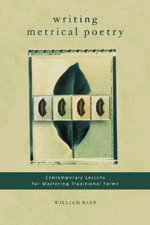Review: Writing Metrical Poetry
Writing Metrical Poetry
William Baer
Writer’s Digest Books
2006
If you find yourself more than a little frightened by the idea of writing formal, metrical poetry, then fear no longer. The good news is that help exists. Published in 2006, William Baer’s Writing Metrical Poetry is a great introductory-level book for the poet interested in working within popular traditional forms.
My personal philosophy is that poetry, while being a high form of art, is also a very disciplined craft. There’s a mystique when it comes to poetry, a romanticized image of the poet (who never really practices at poetry) simply walking through a wooded glen which, naturally, opens up upon a vast, angry, writhing ocean. The poet sits upon a pile of jagged, wave-battered rocks just as the sun is setting—painting the sky a myriad of cliché, inspirational colors—and, lo and behold, the poet realizes the poem the way a Buddhist monk realizes enlightenment.
Well, William Baer scoffs at this image of the poet and begins the reader down a very useful and insightful path to gaining a greater level of understanding not only of metrical poetry, but of free verse and language itself. One of the points he makes is to argue that if a wood sculptor is expected to learn his art from a mentor—being taught the various tools, methods, and styles for shaping wood—then why is it that poets presume to skip this “learning the foundation of your craft” phase of their development?
So what Baer manages with Writing Metrical Poetry is a thorough introduction to reading, understanding and writing formal meter. He explores all of the major formal styles such as the sonnet, the terza rima and the ever-exciting blank verse, while also speaking in depth about the basic structures of poems (i.e. analyzing the quatrain vs the tercet vs the couplet and so on). Much of the book consists of presenting famous metered poems and then examining them closely so that both the uninitiated and the veteran metrical writer can find something new and beautiful within them.
(And, for those of you that were wondering, he’s much less preachy about his bias for learning meter than I am.)
If the book holds any flaw, it is that Baer, sometimes, fails to fully elaborate on specific, esoteric terms. At one point he kicks out the terms “amphibrach” and “choriamb” and leaves no explanation, forcing one to ask the all-knowing Google. Faux pas, Mr. Baer…major faux pas!
But the thorough and intriguing writing exercises that litter the book easily make amends for Baer’s minor lapses in analytical etiquette. Both beginning and experienced poets will find his metering exercises appropriately stimulating, challenging and frustrating (as all good poetry writing should be).
Overall Rating: 4 out of 5
You’ll like this if you’re interested in: formal poetry, metering, writing exercises, sonnets, terza rima, blank verse and other classical forms.
Where to find it: most major book retailers.
Sample:
“Serious poets love to talk about metrics, which is generally a good thing, but being poets…, they can often go overboard. Thus every few years, someone will put forth some “new” and “much more accurate” system of notation for characterizing poetic rhythm. Or somebody will suddenly “discover” that trochees are really the basic foot in the English language. Or others will insist that “true” scansion involves using all of the classical feet…to accurately render the sounds of our poetry. All of this can be rather disconcerting for aspiring poets, who should simply ignore it. As the great American poet Howard Nemerov once said:
I have only two rules in prosody: One is, it goes ta dum ta dum ta dum ta dum ta dum, and the second is, try not to sound like that.”
Follow responses to this entry through the RSS 2.0 feed.
